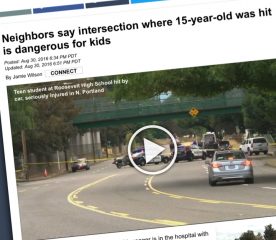
It’s been about 15 months since high school freshman Bradley Fortner was nearly killed while trying to walk across North Columbia Blvd on his way to his first day of school. He was hit by a pickup truck driver and spent a week in the ICU with swelling in his brain.
Fortner lives in a part of north Portland that is effectively walled off from George Middle School and Roosevelt High because of how dangerously people drive on Columbia Blvd. Prior to the collision, his family and neighbors said the road was so wide and so full of trucks and speeding drivers that they knew a tragedy like that was “inevitable”.
There’s a pedestrian overpass at this location, but it’s so unkempt and out of the way that most people opt not to use it.
Advertisement
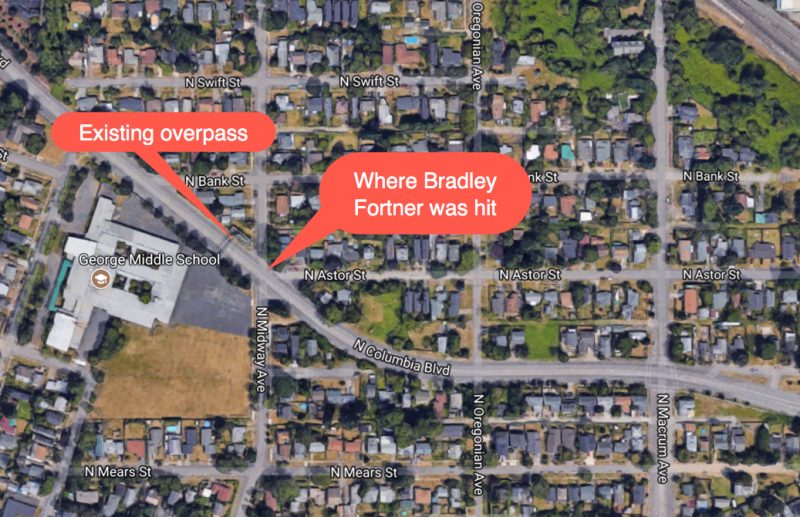
Three months after Fortner was hit, 75 people packed a community forum on traffic safety in St. Johns. Resident and neighborhood leader Travis Parker expressed his frustrations. “To say that ODOT won’t do anything about Columbia because they want to prioritize freight is insane,” he said. “People are dying.”
Now with $1.5 million set-aside in the statewide transportation package, the City of Portland is working on a new solution to tame Columbia and make it safer for people to cross.
It just so happens that this district is represented by the Speaker of the Oregon House of Representatives, Tina Kotek. She’s partnering with Portland’s Safe Routes to School program to host a community meeting on November 27th at Roosevelt High School. In a statement about the meeting Speaker Kotek said she wants feedback, “On how this project will best serve the community.” “The evening will include activities that will allow the community to directly engage with Portland transportation staff about this project. Light snacks and a kid’s activity station will be provided.”
If you live, ride or work in this area and care about traffic safety in St. Johns, please consider attending.
— Jonathan Maus: (503) 706-8804, @jonathan_maus on Twitter and jonathan@bikeportland.org
Never miss a story. Sign-up for the daily BP Headlines email.
BikePortland needs your support.


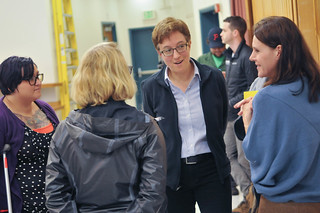

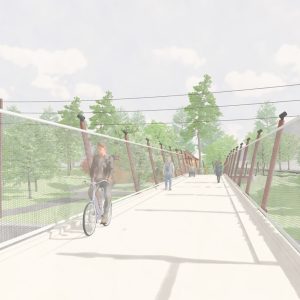
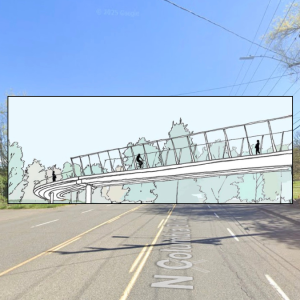
Thanks for reading.
BikePortland has served this community with independent community journalism since 2005. We rely on subscriptions from readers like you to survive. Your financial support is vital in keeping this valuable resource alive and well.
Please subscribe today to strengthen and expand our work.
The same Tina Kotek that we fought on the I-5 highway expansion project(CRC)?
https://bikeportland.org/2011/03/07/rolling-with-momentum-crc-subject-of-public-forum-tonight-49269
I bet if you showed the Dutch this map, with the school on the opposite side of a busy high speed motorway from a large neighborhood and no decent pedestrian over/underpass they would marvel that our country was even sophisticated enough to maintain a written language.
I agree – the Dutch designs [that I have used] of over / under crossings are much better. The sad thing is that most US highway engineers (and their bosses) who design such crossings do not see themselves as end users of these facilities otherwise they would look less like “prison shoots” …
https://www.google.com/maps/@45.5963343,-122.73484,3a,75y,258.62h,84.48t/data=!3m6!1e1!3m4!1sArj_joQOEcV2Mt0w5ky4RA!2e0!7i13312!8i6656
Sadly – the US DoTs (ODoT etc) concept of an overcrossing would likely say that this one is “very good” …and that fact that it exists, gives testimony they they did not ignore the issue back in the day (1980s?)…and there might not even be an overcrossing (no matter its functionality) if this project had been built later in the 1990s(?) due to budget.
There is always a need for BOTH a surface and grade separated pedestrian crossing of a 5 lane (and 3 lane) freight corridor … give pedestrians a choice: less “scary” direct route at night if not congested or a longer climb over traffic in the daylight.
I just looked at that crossing again, and I marvel that it has no stairway, only a looooong ramp. No wonder many people eschew it.
Happy to see movement on this, and I plan to attend, but it’s not exactly complicated. Is there any solution other than 2 or 3 new signaled crosswalks? I mean not only is it the only actual fix, but it’s probably the only thing in a 1.5M budget.
Both that intersection at Midway and Columbia and the intersection of Midway and Fessenden are both just miserable for all modes. A lot of pedestrians, a lot of cars, and the speeds are just too high.
I’m glad there’s some budget and impetus to take it seriously on Columbia at least.
One of the students in this year’s PSU Traffic & Transportation class, a 22-year resident of the neighborhood who is new to transportation advocacy, took on this problem area as her class project. She has developed a list of suggested improvments and has been coordinating with Kotek’s office on costs and implementation strategies. If you go to this meeting, look for Pat Jewett – she is passionate, committed, and has a lot of good ideas worth supporting.
Columbia would work well as a modern roundabout corridor with medians between the roundabout intersections. The traffic volume supports a single lane in each direction. The curb lane could be converted into a protected bike lane or landscape strip, low so wide loads could still get through.
A median down the middle would reduce delay from turning vehicles, reduce the probability of head on crashes, and provide refuge islands for every minor cross street where pedestrians cross.
Roundabout intersections would permit those wanting to go the other direction to used them as safe U-turn locations.
Add to all this the freight corridor nature of the road, the current delay truck drivers experience with the current signals, and the potential reduction in delay if the signals were converted to roundabouts.
With one lane in each direction, the speeders wouldn’t be enabled anymore either.
Cost you say? $300k-$2M per intersection. median runs around $200/foot.
Benefit? Less speeding, less delay = less pollution, safer intersections where heavy trucks operate. One close call per this story, but recall a fatal at Interstate place this year already. The Fed’s put the societal value of a life near $9M.
So our budget to get to zero would be about $400M/yr you say?
Roundabouts are not ideal for pedestrians, as there’s no place where traffic has to stop. Able-bodied, sighted pedestrians can usually make it across the “in” lanes, but the “out” lanes are still scary, as they’re not a 90 degree turn, so vehicles are going fast onto the “off-ramp”.
I have a great concern that those living north of Columbia Blvd will continue to be an auto-dependent, isolated community. The Fessenden-St Louis closure to freight was a first step to removing the divide a busy defacto freight route imposed. There is much more to be done. The same division of the community by Columbia Blvd by high volume traffic, including an abundance of heavy freight is a thornier issue to resolve because Columbia Blvd IS the truck route. I cannot expect diverting freight off Columbia could happen as doing so would increase freight in corridors where it would be even less welcome. Bear in mind the ped bridge at George Middle school is one of two obstacles to oversight freight being diverted off Lombard through North Portland owing to its low clearance height. I have no idea where to begin. the collision of history, expediency and geography create a challenge to resolution. Best wishes.
Hi Joe! Speaking the truth.
But.
Pat Jewett lives north of Columbia, rides and walks frequently around St. Johns, and desires to show other neighbors it is possible. It is only a rough mile or so to the plaza via bike for those north of Columbia. An improved Midway crossing is huge.
Until more extensive calming and smart networking can be implemented ODOT must allow posted mph limit to be lowered. Radar enforcement too.
What’s baffling to me is that so many drivers can’t figure out the difference between a yellow, blinking red, and solid red light. “I just don’t understand what to do – there’s no green light!”
https://www.nbcbayarea.com/news/local/New-Traffic-Lights-in-Santa-Clara-Leave-Drivers-Baffled-430054623.html
Even Rajeev’s explanation is wrong: once the pedestrian has crossed, the driver can only proceed when the red light turns off, and not treat it as a “yellow” signal as described. (Our Director of Public Works should certainly know that).
So the moral of the story is, whatever treatment you decide to put on Columbia… make sure it doesn’t confuse those poor drivers!
Well, the little darlings are rather easily confused. Just look at how few of them know what those ubiquitous red octagonal signs with with letters and outlines mean. One might think the word “STOP” on them would make them self-explanatory, but then one would be wrong. If the required standard is to not confuse motorists, this project is going to be a lot harder than anyone thought.
I hope you appreciate the irony in that statement.
For Pedestrian Hybrid Beacons, drivers can go after stopping during the flashing red phase if the crosswalk is clear. Flashing red = stop sign.
And the Hawk (?) signals have a flashing orange (which means slow down and look, but you don’t necessarily have to stop), and then it changes to flashing red (equivalent of a stop sign, where you can stop and then go), which abruptly changes to solid red (where you stop and stay stopped). They are confusing to those of us who have been used to green-orange-red, and flashing orange (only) and flashing red (only). The sequence is unexpected, as it is not in common with any other signal type. Just stick to Green-orange-red, if you want consistent driver behaviour.
Clearly the solution is to dig a long trench, take Columbia below grade for a few blocks and cap that portion of the road, creating a long greenspace connecting both sides of the neighborhood . . .
Oh, right. $$$. Okay, I vote for paikiala’s solution.